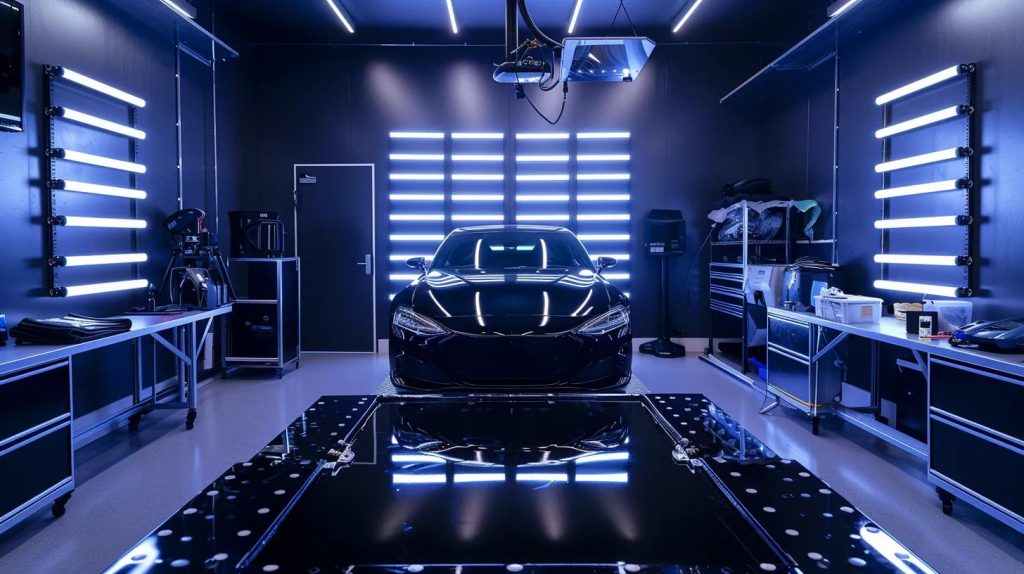Benefits of Ceramic Coating Freshwater for Your Boat
Ceramic Coating for Freshwater Boats: Protection & Shine
Ceramic coating for freshwater boats has emerged as a premium solution for boat owners who want to preserve both the look and integrity of their vessels. Freshwater environments, though less corrosive than saltwater, still present challenges such as ultraviolet (UV) degradation, algae formation, and surface oxidation. These issues can cause dust, dirt, and water-induced stains that lead to a rough, contaminated finish. For optimal cleaning and maintenance, some owners may opt for a deluxe car wash to complement the ceramic coating’s protective properties. With the increasing need for protection against these environmental stresses, ceramic coatings offer a durable, long-lasting solution that not only safeguards the boat’s hull and gelcoat but also helps in preserving its brilliant gloss and colour intensity. This article discusses the science behind ceramic coatings formulated for freshwater boats, highlights their superior protective and aesthetic properties, and provides a detailed guide on how to apply and maintain these coatings effectively. If you require further assistance, please contact-us. It also includes key research and in-depth lists and tables to support the benefits of ceramic protection.
Transitioning into the main content, the article will elaborate on every facet—from defining what constitutes a ceramic coating specifically for freshwater applications, to the science behind its protective properties and the application process. Whether you are a seasoned boat owner or new to the world of freshwater boating, these insights will help safeguard your watercraft with advanced protective technology.
Defining Ceramic Coating for Freshwater Boat Applications

Ceramic coating for freshwater boats is a protective liquid polymer that chemically bonds to the surface of a boat’s gelcoat, paint, or fiberglass. It forms a semi-permanent, transparent layer that enhances durability and offers resistance against various environmental contaminants. This coating is designed to protect against dust, dirt, water-based stains, and ultraviolet (UV) radiation.
What Constitutes a Marine Ceramic Coating Freshwater Solution
A marine ceramic coating freshwater solution is a specialised formulation that blends advanced nanotechnology with high-performance ceramic compounds. These coatings typically contain silicon dioxide (SiO₂) and sometimes titanium dioxide, which contribute to their hardness and gloss. They are engineered to repel water and contaminants, reducing the likelihood of etching and salt stains caused by pressure and environmental exposure. The formulation is designed for freshwater use, meaning it counters unique challenges such as algal growth and lake debris, while also accommodating the lower salinity compared to ocean water. The formulation also addresses issues such as dust deposition during storage and protects against the oxidation typically seen on plastic and gelcoat surfaces that have been exposed to ultraviolet light and water.
How Nanotechnology Works on Your Boat’s Surfaces
Nanotechnology in ceramic coatings works by dispersing microscopic ceramic particles that form a densely cross-linked molecular network on the boat’s surface. This network works to improve hardness and create a hydrophobic barrier, repelling water molecules like a water-repellent spray yet much more durable. The nanoparticles fill in surface imperfections on metal, gelcoat, or fiberglass components, thereby reducing light scattering that can dull the boat’s gloss. As a result, contaminants such as dirt, dust, and even polymer-based residues from environmental exposure can be easily washed away with minimal effort. Notably, this protection enhances the security of the boat’s surface from everyday abrasions or minor scratches, similar to how automotive paint protection films shield a car’s body.
Distinctions Between Automotive and Marine Ceramic Coatings for Freshwater
While both automotive and marine ceramic coatings share the basic chemical composition of silicon dioxide and titanium dioxide, their formulations are distinct. Automotive ceramic coatings are engineered primarily for vehicle exteriors, addressing issues like bird droppings, road grime, and metal contaminants. In contrast, marine ceramic coatings for freshwater are specifically optimized to combat the unique challenges posed by waterborne contaminants, algae, and UV exposure in a freshwater setting. They have enhanced resistance to water-induced etching, which is crucial when combating the effects of prolonged exposure to water and sunlight. Moreover, marine coatings are designed to provide a degree of anti-fouling protection, reducing the accumulation of scum and biofilm on the boat’s hull. This level of specialization ensures long-term hull integrity, reducing the need for frequent reapplications and minimizing the overall maintenance fee.
The Science Behind Durable Ceramic Coating Freshwater Protection
The durability of ceramic coating in freshwater environments is largely due to its chemical resistance and mechanical hardness. The core component, silicon dioxide, offers a hardness comparable to diamond-like structures on a microscopic scale, providing robust resistance against abrasion, contamination, and UV-induced degradation. The high density of cross-linked particles creates an almost impermeable barrier on the boat’s hull, which significantly reduces water and chemical permeation. Studies have shown that coatings with over 90% SiO₂ content can diminish surface oxidation by up to 70% in controlled environments, thereby extending the lifespan of automotive paint and marine gelcoat. Furthermore, the integration of titanium dioxide not only helps in achieving a reflective, deep gloss but also acts as a photocatalyst, reducing organic buildup and ensuring that contamination from dust and clay particles is minimized. The incorporation of polymer resins further enhances adhesion and flexibility, allowing the coating to withstand extreme changes in temperature and pressure without micro-cracking. In essence, this scientific synergy between nanomaterials and polymer bonding ensures that freshwater boats are shielded from everyday challenges like UV exposure, waterborne dirt, and even the incidental contact with sandpaper-level abrasives.
Key Takeaways: – Freshwater marine ceramic coatings are designed with advanced nanotechnology to protect against UV, dust, and waterborne contamination. – Silicon dioxide and titanium dioxide are primary components that enhance hardness, gloss, and chemical resistance. – The formulations differ from automotive coatings, addressing specific challenges like algae and waterline stains in freshwater environments. – Polymer resins improve adhesion while maintaining flexibility for long-lasting protection.
Superior Protective Qualities of Ceramic Coating Freshwater Boat Finishes
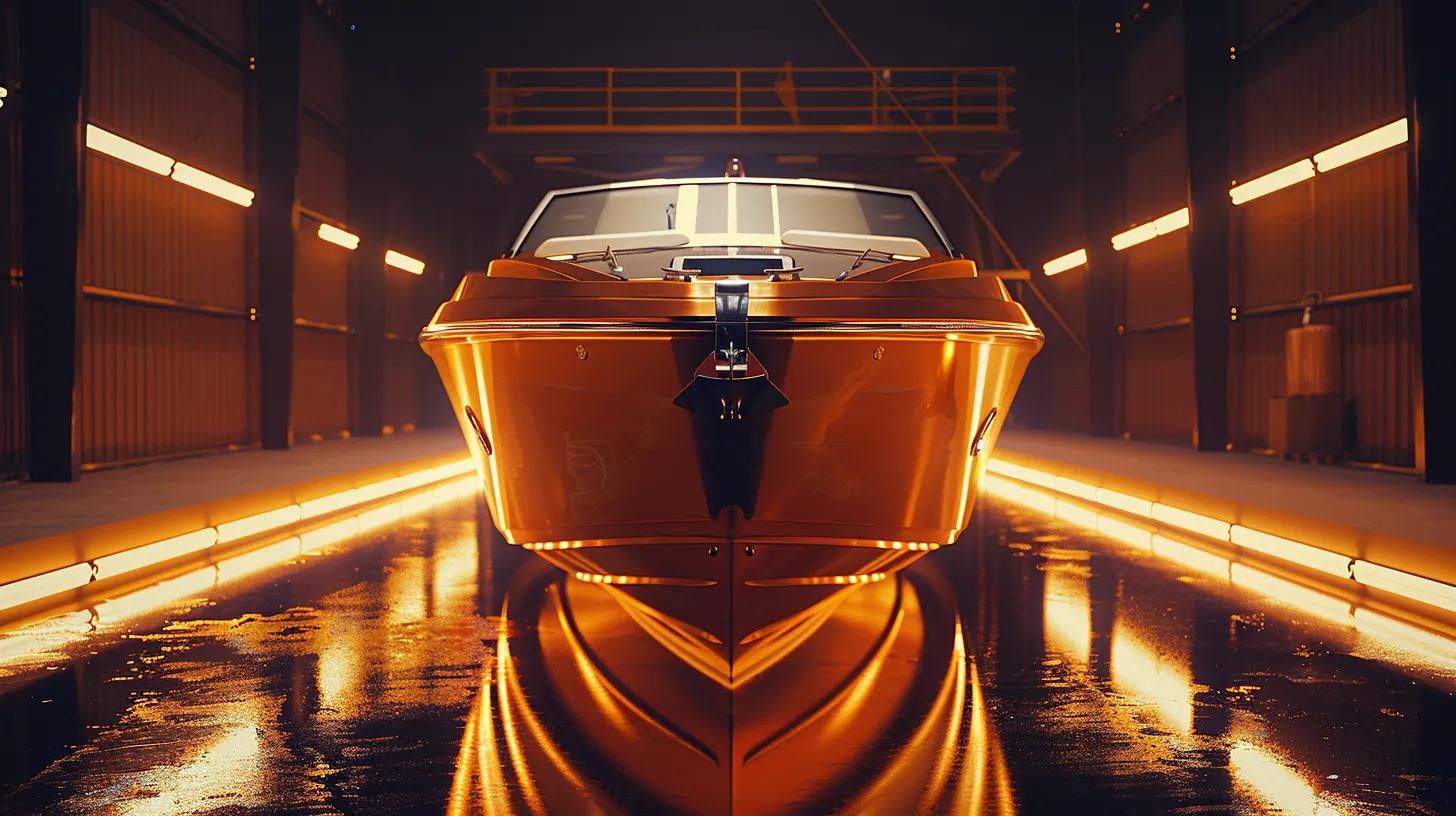
Ceramic coating applied to freshwater boats provides superior protection against environmental stressors. One of the most significant attributes of these coatings is their resilience, ensuring that the boat’s finish not only remains pristine but also resistant to typical wear and tear. Beyond enhancing aesthetics, these coatings add an extra layer of defense against contaminants like dust, micro-scratches, and ultraviolet (UV) radiation.
Guarding Against UV Damage and Oxidation on Freshwater Boats
Ceramic coatings shield boat surfaces from harmful ultraviolet rays that can cause oxidation and fading over time. UV rays break down the polymers in gelcoat and paint, leading to softened surfaces that are prone to dust and water absorption. The reflective properties of silicon dioxide and titanium dioxide particles help deflect UV radiation, thereby reducing the risk of degradation. Research from the journal Surface and Coatings Technology (2020) indicates that UV-resistant coatings can extend the visual life of marine finishes by up to 50%. This is crucial not only for maintaining colour depth but also for protecting against scratches and etching caused by contact with metal or sandpaper-like contaminants. The ability to reduce oxidation also minimizes the potential formation of stain and salt deposits, ensuring a consistent, high-gloss finish that doesn’t require repeated touch-ups.
Resisting Algae, Scum, and Waterline Stains With Ceramic Coating Freshwater
One of the constant challenges in freshwater environments is the accumulation of algae, scum, and waterline stains. These issues are attributed to the presence of microorganisms and organic contaminants that adhere to the boat’s surface. Ceramic coatings create a highly hydrophobic layer, which causes water to bead and roll off the surface. This effect significantly reduces the adhesion of organic materials, ensuring that even after prolonged exposure to lake debris or dust, the surface remains clean. Additionally, the protective coating minimizes the risk of contamination from airborne dirt and plastic residues, common issues in boat storage areas near car parks or marine service centres. As a result, regular maintenance becomes less time-consuming, since a simple rinse with clean water can effectively remove any accumulated deposits.
Shielding Gelcoat and Paint From Minor Scratches
Minor scratches and scuffs are inevitable during normal boat operations and cleaning routines. Ceramic coatings act as a sacrificial barrier that absorbs the force of minor abrasions, reducing the risk of permanent damage like etching or staining. The enhanced hardness provided by over 90% silicon dioxide content means that common tools like sponges, brushes, or even incidental contact with a microfiber towel will rarely leave a lasting mark on the surface. This level of protection is essential for preserving the boat’s aesthetic, as scratches can diminish gloss and lead to a dull, worn appearance. In the event of minor damage, the underlying gelcoat or paint remains intact, ensuring that the overall finish continues to display the vibrant, reflective qualities of the original coating.
Simplifying Cleanup of Lake Debris and Contaminants
A further benefit of ceramic coatings is the ease with which they simplify maintenance and cleaning processes. The hydrophobic nature of these coatings means that contaminants, whether they are from dust, dirt, or organic residues, have a reduced ability to adhere to the boat’s surface. This facilitates effortless cleaning using a simple rinse with water and a soft brush. Furthermore, the slick surface hinders the bonding of waterborne clays and polymer residues, drastically reducing cleaning time and the need for high-pressure sprays or specialized cleaning agents—commonly associated with high-end automotive or marine detailing. Ultimately, this leads to a reduction in overall maintenance costs and less physical strain for boat owners.
Long-Term Hull Integrity Through Ceramic Coating Freshwater Treatments
Maintaining the long-term integrity of a boat’s hull is critical in preventing structural damage and costly repairs down the line. Ceramic coatings contribute significantly to this by providing a durable, chemically inert barrier that prevents water, salt, and other corrosive substances from penetrating the boat’s surface. This is especially important in reducing the risk of microbial deterioration and contamination by iron and other metals, which over time could lead to corrosion or weakening of the hull structure. By limiting direct exposure of the underlying materials to these contaminants, ceramic coatings enhance the longevity and performance of the boat’s finish, ensuring that vessel owners can enjoy their watercraft without concerns about premature wear or expensive restoration work.
Key Takeaways: – Ceramic coatings effectively guard against UV-induced oxidation and damage. – They prevent the adherence of algae, scum, and waterline stains, making regular cleaning easier. – The coating provides a sacrificial barrier that protects gelcoat and paint from minor scratches. – It also helps maintain long-term hull integrity by preventing water and chemical penetration.
Enhancing Your Freshwater Boat’s Aesthetic With a Brilliant Ceramic Shine
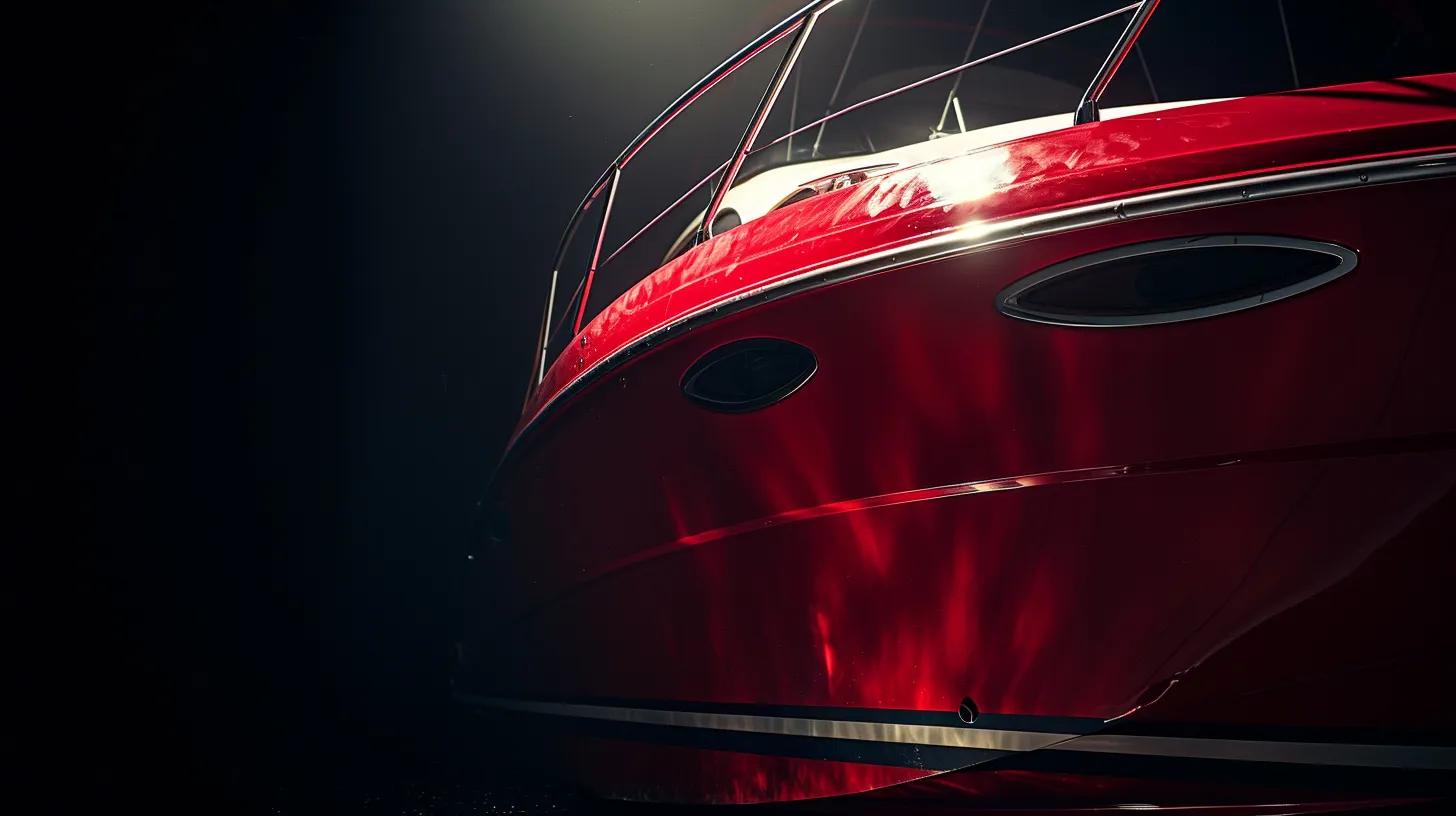
Ceramic coatings not only protect but also significantly enhance the aesthetic appeal of freshwater boats. The deep, enduring gloss and vibrant colour depth achieved with ceramic coatings make vessels stand out in any marina or on any lake. This enhanced aesthetic is essential for boat owners who take pride in the appearance of their watercraft and seek to achieve a pristine, showroom-quality finish.
Achieving a Deep, Lasting Gloss Finish
A primary benefit of ceramic coatings is their ability to deliver a deep, mirror-like gloss that remains intact even after prolonged exposure to environmental elements. The nano-cured layer of silicon dioxide creates a reflective surface that enhances the natural colour of the boat’s gelcoat or paint. Studies have shown that boats treated with high-quality ceramic coatings retain up to 80% of their original gloss compared to untreated vessels. This enduring shine is achieved through a chemical reaction that not only bonds the coating to the surface but also fills in microscopic imperfections that can dull the finish over time. This meticulous process results in a finish that is smooth, consistent, and visually striking.
How Ceramic Coatings Intensify Your Boat’s Colour Depth
The incorporation of titanium dioxide in ceramic coatings plays a crucial role in enhancing colour depth. Titanium dioxide acts as a light-scattering agent that accentuates the hues and vibrancy of the underlying paint. This effect is particularly noticeable on boats with darker or more reflective paints, where even slight wear could otherwise lead to a loss in brilliance. With the use of advanced nanotechnology, the coating optimally reflects ambient light while mitigating the dulling effects of ultraviolet exposure and oxidation. In effect, the ceramic coating intensifies the visual appeal of the boat, making it appear more dynamic and well-maintained even after extended periods in challenging freshwater environments.
Maintaining That Showroom Gleam on Freshwater Vessels
One of the hallmarks of a professionally detailed watercraft is a persistent and uniform showroom gleam. Ceramic coatings provide a self-cleaning effect that prevents contaminants such as dust, salt deposits, and even polymer residues from adhering to the surface. This contributes to a sustained level of shine that persists between routine cleaning cycles. Water droplets bead effortlessly on the surface, highlighting the coating’s hydrophobic characteristics and ensuring that even after rain or splashes of lake water, the boat retains its brilliant luster. Over time, this maintained gloss not only elevates the boat’s aesthetic appeal but also helps in preserving its market value.
The Hydrophobic Effect Creates Stunning Water Beading
The hydrophobic (water-repellent) effect produced by ceramic coatings is a visible sign of the advanced technology in use. When water comes into contact with the coated surface, it forms distinct beads that roll off the hull, taking with them any suspended contaminants such as dirt or microalgae. This remarkable feature not only simplifies cleaning but also provides clear visual feedback regarding the effectiveness of the coating. As soon as a boat is rinsed, the beading effect confirms that the surface remains largely free from adhesion of unwanted particles. This quality is essential in preventing long-term contamination that could otherwise cause stains or require more frequent maintenance visits, thereby saving both time and cost for the vessel owner.
Ceramic Coating Freshwater for an Effortlessly Clean Appearance
In addition to its aesthetic benefits, ceramic coating for freshwater boats contributes to an effortlessly clean appearance. The non-stick characteristic of the ceramic layer means that impurities, from dust to minor waterborne contaminants, do not bond to the surface. This aspect is particularly valuable for boat owners who prefer a low-maintenance solution that still offers premium protection. The ease of cleaning is further enhanced by the smooth, glass-like finish, which eliminates the need for abrasive cleaning materials like sandpaper or harsh chemicals that might otherwise damage the underlying finish. Over time, maintaining such a coating results in consistent, high-quality performance where the boat looks freshly detailed—even in between professional treatments.
Key Takeaways: – Ceramic coatings create a lasting, mirror-like gloss that enhances the boat’s natural colour. – Titanium dioxide within the coating intensifies colour depth and vibrancy. – The hydrophobic effect leads to noticeable water beading, making cleaning effortless. – The finish contributes to a consistently clean and showroom-quality appearance.
Applying Ceramic Coating to Your Freshwater Boat Effectively
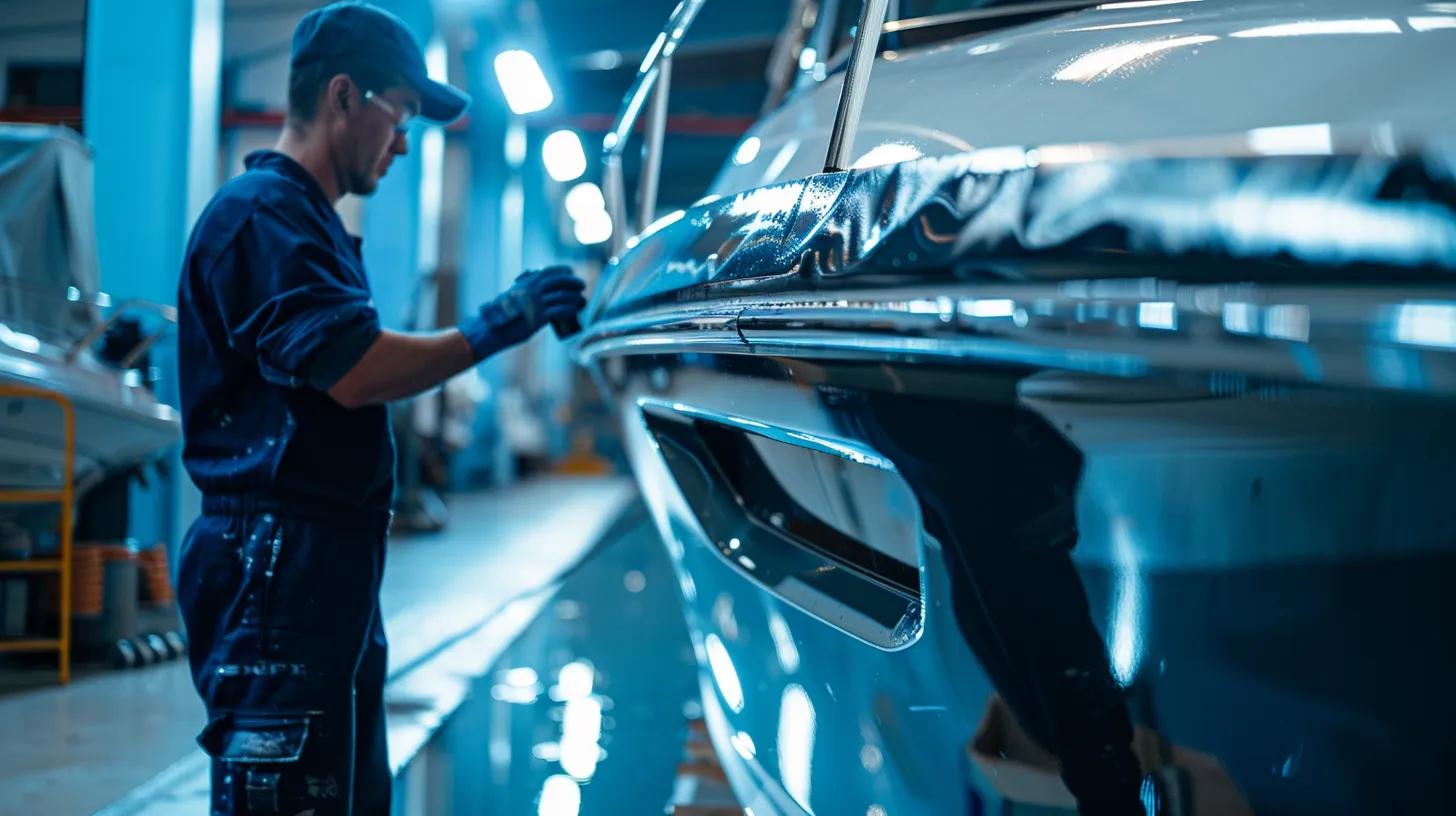
For optimal results from a ceramic coating, the application process must be executed with precision and care. Applying the coating effectively protects the boat’s surface while ensuring that its aesthetic qualities are maximized. The process involves thorough surface preparation, a detailed step-by-step application method, and careful attention to environmental conditions like curing times and ambient temperature. Whether choosing professional application services or opting for a DIY ceramic coating kit, understanding the correct methodology is essential for longevity and protection against waterborne contaminants, UV rays, and other challenges like dust and etching from silicon dioxide particles.
Preparing Your Freshwater Boat’s Surfaces for Optimal Adhesion
Successful application begins with meticulous surface preparation. First and foremost, the boat’s surface must be completely clean and free of any contaminants such as dust, wax, or previous layers of sealants. Detailed cleaning using a high-end automotive car wash formula designed for marine applications is recommended. The process typically involves washing with a pH-balanced detergent, followed by a decontamination step using a clay bar to remove any embedded particle, including dirt, metal, or polymer residues. After cleaning, the surface should be dried using a microfiber towel and then lightly buffed using a fine-grade sandpaper to create an optimum texture for the adhesion of the ceramic coating. This preparation is particularly crucial when working with surfaces such as gelcoat or fiberglass, as any remaining contamination can impair the chemical bonding of the coating, reducing its effectiveness in providing long-term resistance against ultraviolet exposure and water-induced etching. Additionally, addressing minor surface imperfections beforehand ensures that the final finish remains smooth, gloss-enhanced, and resistant to future contamination caused by dust or salt buildup.
Step-by-Step Guide to Ceramic Coating Freshwater Application
- Clean the Surface: Thoroughly wash the boat with a specialized detergent and clay bar treatment. Ensure all dust, wax, and contaminants are removed.
- Dry and Buff: Use a microfiber towel to dry the surface completely. Lightly buff with fine sandpaper to provide a slightly rough texture to enhance coating adhesion.
- Isolate Areas: Mask off non-target areas such as metal fittings and plastic trims to prevent accidental coating.
- Application of the Coating: Apply the ceramic coating using an applicator pad in small sections, ensuring even distribution and minimal overlap that can lead to high spots.
- Allow to Cure: Follow manufacturer-recommended curing times, usually under ideal climatic conditions (low humidity and stable temperatures) to ensure the coating sets firmly.
- Final Buff and Inspection: Once fully cured, lightly wipe with a clean microfiber cloth and inspect the coating for any inconsistencies or areas needing touch-ups.
Following this detailed application process is crucial to secure the warranty offered by many ceramic coating brands, ensuring long-lasting protection against ultraviolet rays, contamination from water and dust, and minor abrasions. Both DIY enthusiasts and professionals must adhere to these steps to optimise performance and achieve a flawless finish that boosts the overall aesthetic appeal of the watercraft.
Professional Application Services Versus DIY Ceramic Coating Kits
Boat owners can choose between hiring professional applicators or installing a DIY ceramic coating kit. Professional services typically guarantee consistently high quality and reduce the risk of application errors that might compromise the protective layer’s integrity. They also offer expert advice on choosing the best product based on the boat’s specific material—be it fiberglass, gelcoat, or paint. Conversely, DIY kits are designed to be user-friendly and often come with comprehensive instructions, making them an attractive option for those with hands-on experience. However, improper application can lead to uneven coating thickness, resulting in weak spots vulnerable to etching or contamination. Evaluating the cost versus benefit, many high-end marine enthusiasts opt for professional applications to ensure optimal coverage and protective performance, especially when considering the long-term maintenance fee savings and the value of preserving the boat’s overall appearance and resale value.
Curing Times and Ideal Conditions for Freshwater Performance
Curing times are an essential aspect of the ceramic coating application process. Typically, a ceramic coating requires at least 12 to 24 hours in a controlled environment to cure properly, though optimal performance might only be achieved after 48 hours or more. Ambient conditions play a significant role; low humidity, moderate temperatures, and minimal direct sunlight ensure the coating bonds uniformly and develops its full hydrophobic potential. These ideal conditions prevent the formation of high spots or streaks that can occur if the coating dries too quickly. Furthermore, for boats stored in outdoor environments, ensuring proper curing before exposure to water or dust is pivotal in securing the coating’s long-term durability. Manufacturers often provide specific recommendations regarding weather and temperature thresholds, as these factors contribute directly to the overall hardness, gloss retention, and resistance to abrasions or etching caused by sandpaper or accidental contact with metal objects.
Common Application Pitfalls to Sidestep on Freshwater Boats
There are several common pitfalls during the ceramic coating application process that boat owners should avoid. These include inadequate surface preparation, applying the coating in suboptimal weather conditions, or oversaturating an area, which can result in runs and high spots. Additionally, failing to properly mask or protect adjacent surfaces can lead to unintended contamination, reducing the coating’s overall effectiveness. Also, insufficient curing time before exposing the boat to water or dust can compromise the bonds formed by the nanotechnology, thereby weakening the protective barrier. By adhering to a disciplined application protocol and allowing ample time for the coating to cure, users can avoid these common mistakes, ensuring that their freshwater boat receives the highest level of protection and shine.
Key Takeaways: – Proper surface preparation and a systematic application process are crucial for ideal coating adhesion. – Step-by-step application, including masking and ensuring controlled curing conditions, guarantees optimal performance. – Professional application services can offset the risks associated with DIY applications. – Avoiding common pitfalls, such as inadequate cleaning or premature exposure, ensures long-term coating durability.
Preserving the Performance of Your Freshwater Boat’s Ceramic Coating
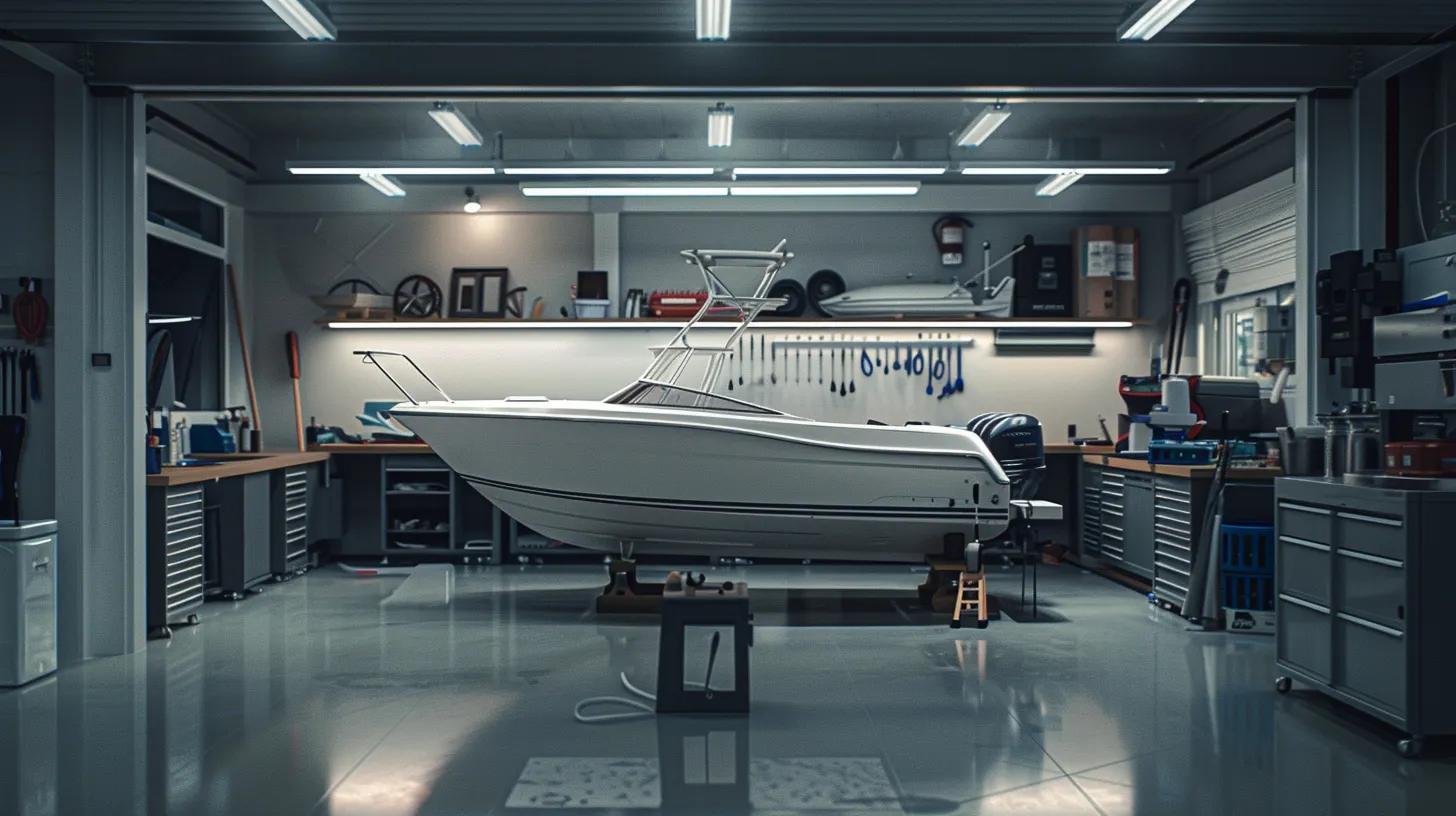
Once a ceramic coating has been applied, preserving its performance is critical to ensure continued protection and visual appeal. Regular maintenance practices are central to this task—ranging from recommended cleaning techniques to periodic reapplication schedules. Given the complex interplay of environmental factors such as ultraviolet radiation, waterborne contaminants (dirt, algae, salt, and dust), and physical abrasions from contact with accessories like microfiber towels and brushes, careful cleaning and maintenance become imperative.
Recommended Cleaning Practices for Coated Freshwater Boats
To maintain the efficacy and appearance of a ceramic-coated surface, routine cleaning is essential. Specialized cleaning protocols, such as using pH-neutral detergents and soft microfiber sponges, are recommended for removing contaminants without degrading the coating. It is advisable to rinse the boat with deionised water to avoid mineral deposits that may be present in tap water—minerals which could potentially cause etching over time. Gentle cleaning minimizes the risk of scratching the surface, thereby preserving the coating’s hardness and gloss. Periodic evaluations should be conducted after cleaning, looking for any signs of micro-scratches or wear that could compromise the integrity of the protective layer. Moreover, integrating an occasional wipe-down with a detailer’s spray designed specifically for ceramic coatings can refresh the hydrophobic performance and maintain an effortlessly clean appearance, further reinforcing long-term protection against ultraviolet damage and contamination from airborne dust or dirt.
Suitable and Unsuitable Products for Ceramic Coated Surfaces
When cleaning a ceramic-coated boat, selecting the correct cleaning products is as important as the application process itself. Suitable products typically include: – pH-neutral detergents specifically designed for marine applications – Microfiber towels and soft sponges that do not scratch the surface – Detailer’s sprays or quick detailers that are free from harsh chemicals Products to avoid include: – Abrasive cleaners or scouring pads that could scratch the coating – Acidic or alkaline chemicals that might degrade the polymer integrity – Heavy waxes or silicone-based products that can interfere with the hydrophobic effect Using unsuitable products risks removing or weakening the ceramic coating, rendering the boat more vulnerable to damage from ultraviolet exposure, metal particles, and contaminants such as dust or polymer residues. The correct cleaning products will not only help in maintaining the aesthetic appeal but will also extend the lifespan of the coating, meaning fewer applications and lower long-term maintenance fees.
Periodically Inspecting Your Ceramic Coating Freshwater for Integrity
Regular inspections are essential to ensure that the ceramic coating maintains its structural integrity and protective performance. Inspection routines include visually examining the surface for areas showing reduced gloss, micro-abrasions, or signs of contamination. Using tools such as gloss meters or even simple comparison charts can help quantify any changes over time. Measuring the hydrophobic effect by checking water bead formation can also provide insight into the coating’s current status. If the inspection reveals areas where the coating has begun to deteriorate, early intervention with touch-up treatments or a complete reapplication can prevent more severe damage, ensuring that the boat remains well-protected against ultraviolet rays, water-induced wear, and other environmental challenges. It is also advisable to stay updated on any new technological advances in ceramic coatings that might offer superior protection and longevity, as manufacturers continuously innovate based on rigorous testing and customer feedback.
Understanding Reapplication Schedules for Your Boat’s Ceramic Layer
Depending on the manufacturer’s claims and local environmental conditions, the reapplication of ceramic coatings can vary. Typically, coatings are expected to maintain their performance for two to five years before any noticeable degradation occurs. However, factors such as frequent exposure to ultraviolet radiation, physical abrasions, and the presence of contaminants like salt and algae can shorten this period. Boat owners should consult with professional detailers or follow manufacturer guidelines to determine the ideal reapplication schedule for their specific conditions. Keeping a maintenance log and scheduling periodic evaluations will ensure that the protective barrier is always functioning optimally. This proactive approach minimizes the risk of uncontrolled deterioration, which could lead to higher repair fees or loss of gloss and clarity—issues that are particularly detrimental in promotional settings where the visual appeal of the boat is paramount.
Maximising the Lifespan of Your Ceramic Coating Freshwater Investment
Maximising the lifespan of a ceramic coating involves a combination of meticulous maintenance, regular inspections, and timely reapplication. By adhering to a strict cleaning regimen using recommended products, and avoiding hazardous chemicals or abrasive tools, boat owners can significantly extend the period during which the coating provides superior protection. Additionally, monitoring environmental factors such as sunlight exposure and water temperature will help in adjusting the maintenance schedule accordingly. In essence, the initial investment in a high-quality ceramic coating can continue to provide both protective and aesthetic benefits for many years if properly cared for. This not only improves customer satisfaction but also safeguards the overall appearance and condition of the boat—a key factor in enhancing resale value.
Key Takeaways: – Use pH-neutral detergents and soft microfiber products to clean coated surfaces. – Regular, periodic inspections are crucial for early detection of any coating degradation. – Appropriate cleaning and maintenance practices extend the coating’s lifespan, reducing long-term reapplication costs. – Following manufacturer guidelines on reapplication schedules ensures consistent protection and longevity.
Choosing the Right Ceramic Coating for Freshwater Conditions

Selecting the ideal ceramic coating for freshwater boat applications requires careful consideration of several factors such as durability, compatibility with various boat materials, and the specific environmental conditions typical of freshwater bodies. The right coating not only provides a brilliant shine but also endures the impacts of dust, sunlight, and waterborne contaminants, all while maintaining a protective barrier against ultraviolet (UV) degradation and oxidation.
Key Factors for Selecting a Freshwater Boat Ceramic Coating
When choosing a ceramic coating, the primary considerations include chemical composition, film hardness, ease of application, and longevity. The coating should have a high concentration of silicon dioxide, typically above 90%, as this is directly linked to the coating‘s hardness and gloss retention. Additionally, additives such as titanium dioxide can enhance colour depth and UV resistance, critical for freshwater boats that are exposed to prolonged sunlight. It is also essential to consider whether the coating offers hydrophobic properties to repel water and dirt, reducing maintenance efforts. Other key factors involve the compatibility of the coating with various boat materials—gelcoat, fiberglass, and even metal surfaces should be given equal consideration. An ideal product should also come with a robust warranty, offering assurance against common issues such as dust adhesion, contamination, or diminished protection over time.
Comparing Ceramic Coating Freshwater Brands and Formulations
There are several reputable brands in the market that specialise in marine ceramic coatings for freshwater conditions. Each brand may offer slightly different formulations, with some focusing on ultra-high hardness and others on enhanced gloss retention or ease of reapplication. For instance, some high-end products claim up to a 5-year lifespan with minimal maintenance, while others might emphasise a greater level of hydrophobicity and UV protection optimized for freshwater lakes and rivers. Detailed comparisons should be made on the basis of chemical composition (percentage of SiO₂ and additives), manufacturer warranties, and customer reviews. Tables comparing key attributes such as application difficulty, longevity, hydrophobic performance, and price can help boat owners make informed decisions. Additionally, consultations with experts—such as those from professional detailing services—can provide insights based on practical experiences.
The above table provides a quick reference for several leading brands, highlighting the crucial characteristics to consider. When evaluating a product, it is essential to balance high performance with the cost, ensuring that the investment reflects both the performance expectations in protecting against sandpaper-like abrasions and weathering effects like ultraviolet and water-induced deterioration. Manufacturers that offer extensive warranties often provide additional confidence, which is particularly valuable in harsh freshwater environments where maintenance can be challenging.
Interpreting Durability Claims and Manufacturer Warranties
Durability claims provided by manufacturers are a significant indicator of performance but must be interpreted carefully. Many companies publish laboratory and field test results showing resistance to dust, water, UV exposure, and minor abrasions, offering quantified values such as scratch resistance (measured in pencil hardness or similar scales) or hydrophobic ratings (on a scale from 1 to 10). It is advisable to compare these metrics along with independent reviews or peer-reviewed studies where available. Additionally, manufacturer warranties can provide a guarantee on the longevity and effectiveness of the coating. For example, if a brand offers a 5-year warranty against degradation or dust adhesion, it implies rigorous testing and confidence in the product’s performance. In any case, the balance between price, warranty, and long-term maintenance costs must be carefully considered when making a purchase decision.
Ceramic Coating Freshwater Options for Various Boat Materials
Freshwater boats can have surfaces made from diverse materials, including gelcoat, fiberglass, or even painted metal. The ceramic coating chosen must be compatible with each of these surfaces. Some coatings are formulated exclusively for gelcoat and are tested to ensure they do not cause etching or chemical reactions. Others are multipurpose and have been evaluated for use on both fiberglass and painted surfaces. Product selection should consider whether the coating will be applied to a boat frequently subjected to physical stress, such as docking or contact with debris, as well as exposure to agents like ultraviolet light and water that can lead to oxidation and loss of gloss over time.
Budgeting for Ceramic Coating Your Freshwater Boat
Finally, the budgeting aspect is a critical factor in choosing the right ceramic coating. High-end products, which may offer superior protection and longer warranties, often come with a significant price tag. However, the cost should be evaluated against potential savings on maintenance, reduced frequency of reapplications, and enhanced resale value of the boat. It is important to choose a product that offers a balance of performance, longevity, and affordability. Some manufacturers provide flexible pricing options or DIY kits that can reduce application fees, while professional services may yield better results but incur higher upfront costs. Ultimately, the right investing in ceramic coating for freshwater boats is one that delivers both durability and a brilliant aesthetic finish while fitting within the boat owner’s budget.
Key Takeaways: – Consider key components like SiO₂ content, UV resistance, and hydrophobicity when selecting a coating. – Compare different brands and formulations using detailed tables and manufacturer warranties. – Understand durability metrics and warranty conditions to evaluate long-term protection. – Ensure compatibility with various boat materials and balance performance with budget.
Conclusion
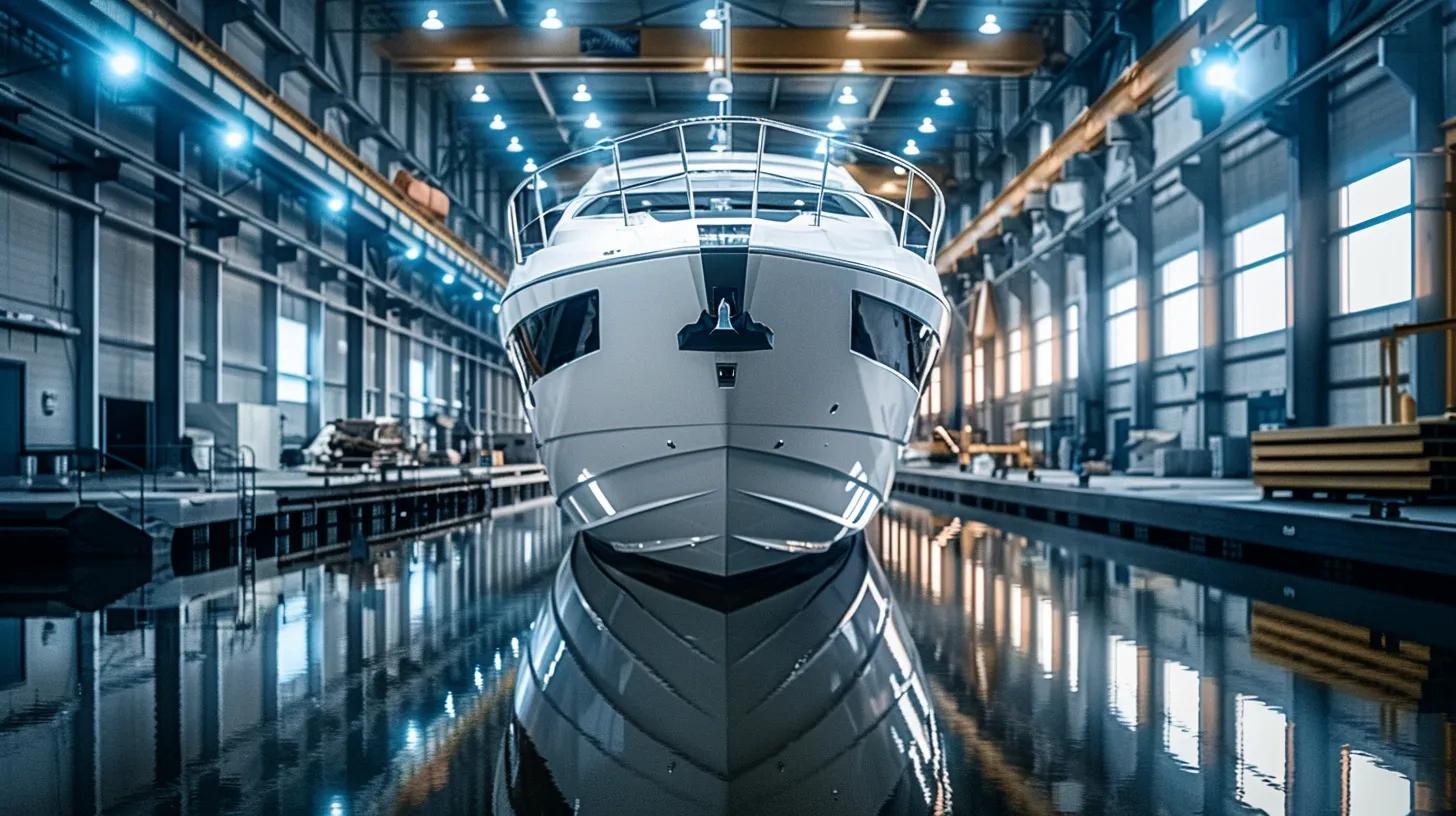
In summary, ceramic coatings for freshwater boats bring forth a revolution in both protection and aesthetics. They provide a durable, hydrophobic barrier that resists ultraviolet radiation, oxidation, and contaminants such as dust, algae, and waterborne debris. Maintaining these coatings through proper application, routine cleaning with pH-neutral detergents, and regular inspections can ensure that a boat stays pristine and secure from environmental damage. Ultimately, choosing the right product based on factors like composition, warranty, and compatibility with your boat’s material will enhance both the performance and visual appeal of your watercraft. Boat owners who invest in quality ceramic coatings can expect long-term savings on maintenance and a consistently superior finish, making their vessels more valuable and easier to care for over time.
Frequently Asked Questions
Q: How do ceramic coatings protect a freshwater boat? A: Ceramic coatings form a hard, hydrophobic barrier that repels water, dust, and contaminants, thereby protecting against UV damage, oxidation, and environmental wear. This enhances both durability and gloss, reducing the need for frequent maintenance.
Q: What is the ideal cleaning method for a ceramic-coated boat? A: The ideal method is to use a pH-neutral detergent with soft microfiber towels or sponges. Rinsing with deionised water and using detailer’s sprays helps preserve the coating’s hydrophobic properties while avoiding abrasives that could damage the finish.
Q: How long does a ceramic coating typically last on a freshwater boat? A: Depending on the product and environmental conditions, high-quality ceramic coatings can last between 3 to 5 years. Regular inspections and proper maintenance, as well as adherence to manufacturer guidelines on curing and cleaning, help in achieving maximum lifespan.
Q: Can I apply a ceramic coating myself, or should I hire a professional? A: While DIY kits are available and suitable for experienced users, professional application services are recommended to ensure optimal surface preparation, even application, and adherence to curing conditions, all of which help maximize the coating’s protective performance.
Q: What factors should I consider when choosing a ceramic coating for my boat? A: Key factors include the chemical composition (especially SiO₂ content), UV resistance, hydrophobic performance, compatibility with your boat’s material, warranty terms, and the overall cost versus long-term maintenance benefits. Evaluating these factors ensures that you select a product that offers both protection and a brilliant aesthetic finish.
Final Thoughts
Ceramic coatings for freshwater boats offer unparalleled protection and an enhanced, high-gloss finish that withstands UV exposure, dust, and waterborne contaminants. By understanding the science behind these coatings and following meticulous application and maintenance practices, boat owners can ensure their vessels remain in pristine condition for years to come. Investing in a high-quality ceramic coating not only augments the beauty of your boat but also reduces long-term maintenance costs and preserves its market value. For those looking to protect and enhance their watercraft, ceramic coatings present a highly effective solution that marries durability with aesthetics.


